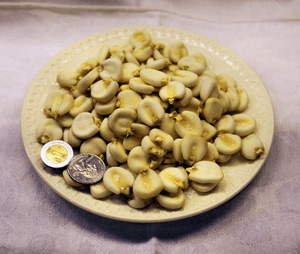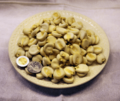Hominy facts for kids

A bowl of cooked hominy
|
|
| Place of origin | Mesoamerica |
|---|---|
| Region or state | Americas |
| Ingredients generally used | Dried maize (corn) kernels |
Hominy is a special food made from dried maize (corn) kernels. To make it, the corn goes through a process called nixtamalization. This means the kernels are soaked and cooked in a special water solution with an alkali, like lime or lye. This process makes the corn softer, easier to digest, and even more nutritious! The word "nixtamalization" comes from the Nahuatl word nextamalli, which means "hominy."
Contents
The Ancient Story of Hominy
The way hominy is made, called nixtamalization, has been very important in Mesoamerican cuisine for thousands of years. This process started a long time ago in places like southern Mexico and Guatemala, around 1500–1200 BC.
To treat the corn, people needed a special powder called lime. The Lacandon Maya, who lived in the tropical areas of eastern Chiapas, made this powder by heating freshwater shells over a fire. In other areas, like the Yucatán Peninsula, people used limestone to create "slaked lime" for soaking the corn kernels.
The ancient Maya used nixtamalized corn to make drinks that were similar to chicha, a type of fermented beverage. They also found that if certain bacteria got into the nixtamal, it could create a kind of sourdough.
How is Hominy Made?
Hominy is made using the process of nixtamalization. Here's how it works:
- First, dry field corn kernels are used.
- Next, these hard kernels are soaked and cooked in a weak solution. This solution is usually made from lye (sodium hydroxide) or slaked lime (calcium hydroxide). Lye can even be made from water and wood ash!
- After soaking, the corn is washed very well. This removes any bitter taste from the lye or lime.
Why Nixtamalization is Important
The alkaline solution (lye or lime) does several important things to the corn:
- It helps break down the "glue" that holds the corn's cell walls together.
- It loosens the tough outer skin (hulls) from the kernels.
- It makes the corn softer.
- Soaking the corn in lye also stops the corn's germ from sprouting while it's stored.
- Most importantly, the lye or lime adds calcium to the corn. It also changes the corn so that a nutrient called niacin can be easily absorbed by your body.
Without nixtamalization, humans can't absorb the niacin in corn. This is why people in the 1700s and 1800s who ate a lot of untreated corn sometimes got a disease called pellagra (which is caused by not enough niacin). Mexican people, however, didn't usually get pellagra because they traditionally treated their corn using this ancient method.
Different Forms of Hominy
Once the corn is treated, it can be used in different ways:
- It can be eaten as whole kernels.
- It can be ground into small, sand-like pieces to make grits.
- It can be ground into flour.
In Mexican cuisine, hominy is often finely ground to make a dough called masa. This fresh masa can also be dried and turned into a powder called masa seca or masa harina. Masa is special because it can form a dough when you add water, unlike regular cornmeal. This dough is used to make delicious foods like tortillas.
Delicious Ways to Use Hominy
The English word hominy comes from a word in the Powhatan language for prepared corn. Many other indigenous American cultures also made hominy and included it in their meals.
For example, the Cherokee people made hominy grits. They would soak corn in a weak lye solution made by mixing water with hardwood ash. Then, they would beat the corn with a special tool called a kanona (ᎧᏃᎾ). They used these grits to make a traditional hominy soup (ᎬᏃᎮᏅ ᎠᎹᎩᎢ), cornbread, or dumplings (ᏗᎫᏅᎢ). After Europeans arrived, they sometimes fried hominy with bacon and green onions.
In Mexican cooking, masa nixtamalera (the dough from nixtamalized corn) is cooked with water and milk to make a thick, warm drink called atole. If you add chocolate and sugar, it becomes atole de chocolate. Adding anise and piloncillo (a type of brown sugar) makes champurrado, a popular breakfast drink.
Other popular hominy recipes include:
- pozole: A Mexican stew with hominy and pork, chicken, or other meat.
- Hominy bread
- Hominy chili
- Hog 'n' hominy
- Casseroles and fried dishes.
In Latin America, many dishes are called mote, which also uses hominy. On many islands in the West Indies, like Jamaica, hominy is used to make a type of porridge. This porridge is thickened with corn starch or flour and often includes condensed milk, vanilla, and nutmeg.
Rockihominy was a popular trail food in the past. It's made from dried corn that's roasted until golden brown, then ground into a very coarse meal, similar to hominy grits. Hominy is also sometimes used as animal feed.
Images for kids
See also
 In Spanish: Nixtamalización para niños
In Spanish: Nixtamalización para niños




